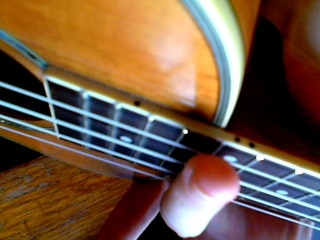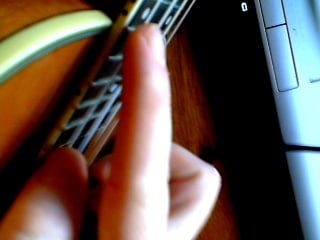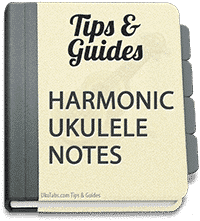When I used to play the guitar and was looking for tabs, I would encounter something called “harmonic notes”. According to Wikipedia, these are “musical notes played by preventing or amplifying vibration of certain overtones of a guitar string”. Harmonics can take a song you are playing to a higher level. They make it a lot more varied by adding a chiming sound. Ukulele harmonics also exist.
Guitar and ukulele harmonics
Like the guitar, the ukulele is a stringed instrument. That means it is possible to play harmonics on the ukulele. It is even a well-known technique in Hawaiian lap steel playing. Ukulele harmonics contain very high-pitched notes and offer a different sound quality.
I have to note though, playing harmonics is a bit more difficult on the ukulele because of the shorter fretboard.
Natural ukulele harmonics
So far so good, but how do we actually play them on the ukulele? You can create a harmonic by first placing a finger of your fretting hand (preferably your index finger) on a string very lightly, barely touching it. The place where you do this is very important and needs to be quite precise.

The easiest way to produce a ukulele harmonic is on the 12th fret. So go ahead and touch the string lightly at the 12th fret (not between frets, but right above the 12th fret). Now pluck the string you are touching with your right hand. Immediately after that you’ll need to lift your finger (left hand).
If you’ve done this correctly you should hear the harmonic (chiming sound), which will be one octave (or 12 frets) above the open string. It should sound like this.
Not getting it right the first time? Don’t worry, hardly anybody does. Keep trying to find the right amount of pressure and get the correct timing of plucking/releasing the string. Not enough pressure will result in the open string being played. Too much pressure will result in no sound at all.
In theory, harmonics can be created on the 12th, 9th, 7th, 5th and 3rd frets, but some are quite tricky to get right. This is how it should sound at the seventh fret, sounding 19 frets higher than the open string.
At the fifth fret it sounds 24 frets or 2 octaves higher than the open string. As you can hear from the sound bite below, it’s very tricky to get perfectly right.
Artificial harmonics

Great, now you know what natural ukulele harmonics are! Unfortunately, the number of harmonic notes you can play is very limited, especially on a ukulele fretboard. And that’s where artificial harmonics come in. It is not that easy to play them, but they will allow you to play different harmonic notes at different places along the fretboard.
There are two steps to playing an artificial harmonic note.
- Fretting
Simply fret a note as usual (with your fretting hand).
- And play a harmonic
This is a tricky one, because basically you’ll have to do the same action as with natural harmonics, but with only one hand (your strumming hand). Point your index finger and pick the note.
This is how a artificial harmonic can sound on the 12th fret, but nothing stops you from trying it on the 7th and 5th frets as well.
There are different techniques for this. Simply use the one that suits you best (or maybe use your own technique).
For example, you can use your index finger to hold the string (cf. with natural harmonics this was a finger of your fretting hand) and picking with your ring or middle finger. Of course your thumb or even pinkie would work as well.
Instead of your index finger, you could also try another finger. I like to touch the string with my index finger and pick with my thumb. The trick is to the right position for you and keep practising!
Now, where do you this “action” with your strumming hand? You’ll want to do it twelve frets up from where you are fretting the note (see step one, two paragraphs above), thus playing in harmonics. It should also work 5 or 7 frets higher, but as noted before, these harmonics are a bit more difficult to get right.
Final note: how are these ukulele harmonics shown in tabs?
Maybe you have already come across the symbol for harmonic notes but didn’t know what it meant? Well, now you’ll know! Harmonic notes are noted in tablature with a diamond shape “♦” (this is a text symbol and can be typed easily). Below I have added an example of how it will look in text tablature.
xA|------------------♦12--| xE|-------------♦12-------| xC|-------♦12-------------| xG|--♦12------------------|
In this sequence the open C string is played with the artificial harmonic at the 12th fret. Then fret at the 2nd fret and play the artificial harmonic at the 14th fret. Then finger the fourth fret and play the artificial harmonic at the sixteenth.
xA|------------------|------|| xE|------------------|------|| xC|--♦0--♦2--♦4--♦2--|--♦0--|| xG|------------------|------|| | | | | | C D E D C
Once you’ve got the hang of these, you can work out how to play tunes using harmonics.
xA|-----------♦0--|-----------♦2--|--♦3-----------|| xE|--------♦1-----|--------♦1-----|--------♦0-----|| xC|-----♦0--------|-----♦2--------|---------------|| xG|--♦2-----------|--♦0-----------|-----♦0----♦0--|| | | | | | | | | | | | | A C F A G D F B C G E C
Hopefully you understand now what those mysterious-sounding harmonic notes are and how you can play them on the ukulele!
Need more input?
Feel free to contact me whenever you need more information about playing ukulele harmonics.Also interested in a very brief history of the ukulele?
